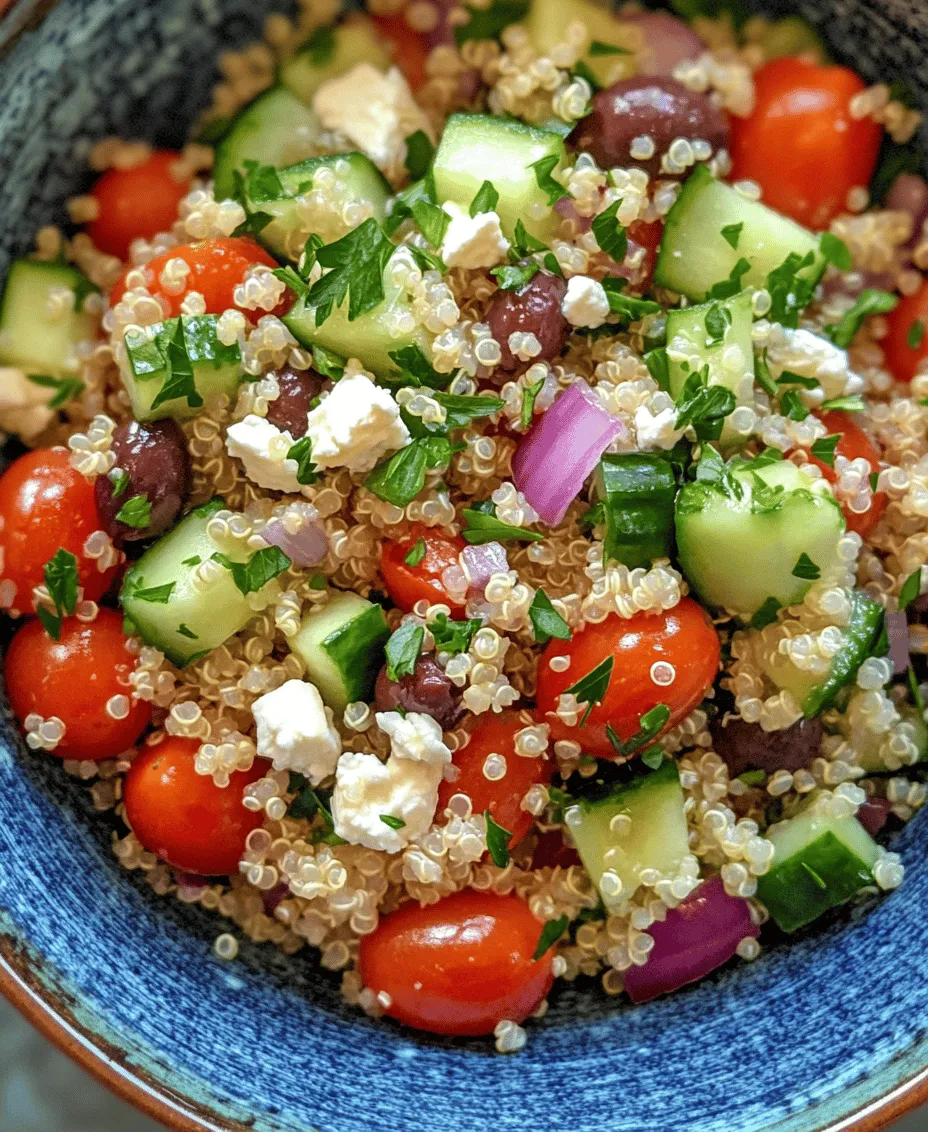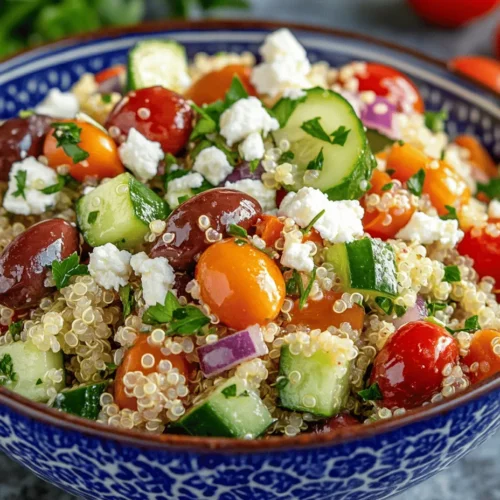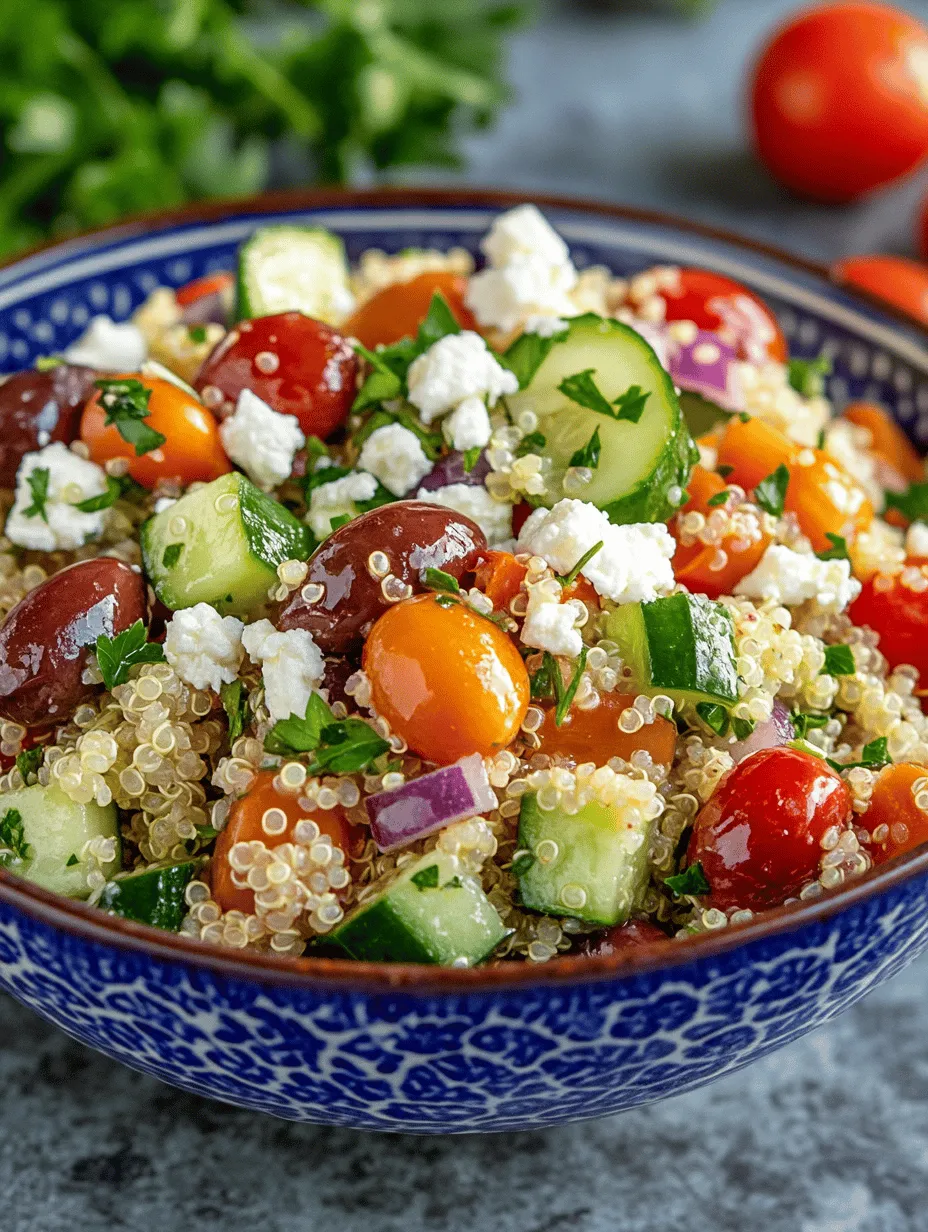Introduction
The Mediterranean Quinoa Salad is a vibrant and nutritious dish that captures the essence of the Mediterranean diet, celebrated for its health benefits and delicious flavors. Combining protein-packed quinoa, an array of fresh vegetables, and a zesty dressing, this salad is not only a feast for the eyes but also a wholesome addition to your meal plan. Whether you’re looking for a light lunch, a side dish for dinner, or a healthy option for meal prep, this salad promises to deliver on taste and nutrition.
This article will guide you through the recipe for this refreshing Mediterranean Quinoa Salad, exploring the key ingredients and their benefits, while providing step-by-step instructions to ensure your dish comes out perfectly every time. In a world increasingly focused on healthy eating, quinoa has made its mark as a superfood staple, and this salad is a fantastic way to incorporate it into your diet while enjoying the vibrant flavors of the Mediterranean.
Understanding Quinoa: The Superfood Staple
Exploring the Origins of Quinoa
Quinoa, often referred to as a grain, is technically a seed from the plant Chenopodium quinoa. Native to the Andean region of South America, particularly Peru, Bolivia, and Ecuador, quinoa has been cultivated for thousands of years, valued by ancient civilizations for its nutritional properties. The Incas dubbed quinoa the “mother grain,” and it was a staple in their diet for its resilience and adaptability to various growing conditions. In recent years, quinoa has gained popularity worldwide, particularly in health-conscious communities, due to its impressive nutritional profile and versatility in cooking.
The Nutritional Benefits of Quinoa
One of the most appealing aspects of quinoa is its remarkable nutritional content. Unlike many other grains, quinoa is a complete protein, meaning it contains all nine essential amino acids that the body cannot produce on its own. This makes it an excellent protein source for vegetarians and vegans. In addition to being rich in protein, quinoa is also high in dietary fiber, vitamins, and minerals. A single serving of cooked quinoa delivers essential nutrients like magnesium, iron, and B vitamins, making it a powerful addition to a balanced diet. Furthermore, quinoa is gluten-free, making it suitable for those with gluten sensitivities or celiac disease.
How Quinoa Fits into a Balanced Diet
Incorporating quinoa into your diet can contribute to various health benefits. Its high fiber content supports digestive health, while its low glycemic index helps regulate blood sugar levels. This means that quinoa can be beneficial for individuals managing diabetes or those looking to maintain stable energy levels throughout the day. Additionally, quinoa is versatile and can be used in various dishes, from salads and soups to grain bowls and savory sides. By swapping out less nutritious grains with quinoa, you can enhance the overall nutritional value of your meals.
Key Ingredients and Their Benefits
A Mediterranean quinoa salad is not complete without its array of fresh ingredients, each contributing unique flavors and nutritional benefits. Here are the key ingredients that make this salad not only delicious but also nutritious.
Highlighting Fresh Ingredients
Fresh ingredients are the heart of any Mediterranean dish, and this salad is no exception. By choosing high-quality, seasonal produce, you can elevate the flavor profile and ensure maximum nutritional benefits. The combination of colors, textures, and flavors in this salad not only makes it visually appealing but also provides a well-rounded nutrient profile.
Cherry Tomatoes: A Burst of Flavor and Nutrition
Cherry tomatoes are a staple in Mediterranean cuisine, known for their sweetness and juiciness. These small, vibrant tomatoes are packed with vitamins A and C, antioxidants, and lycopene, which is linked to numerous health benefits, including reduced risk of certain cancers and heart disease. Their bright color and refreshing taste add a delightful pop to the salad, making every bite a burst of flavor.
Cucumber: The Refreshing Crunch
Cucumbers are synonymous with freshness and hydration, making them a perfect addition to any salad. With a high water content, they help keep you hydrated while providing essential vitamins and minerals, including vitamin K and potassium. The crisp texture of cucumbers adds a satisfying crunch to the salad, balancing out the softness of the quinoa and cheese.
Red Onion: Adding Depth and Sweetness
Red onions bring a unique flavor profile to the salad, offering a mild sweetness that complements the other ingredients. They are also rich in antioxidants and contain anti-inflammatory properties. The vibrant purple hue of red onions adds visual appeal, making the salad even more enticing. To mellow the flavor, consider soaking sliced red onions in cold water for a few minutes before adding them to the mix.
Kalamata Olives: A Mediterranean Essential
Kalamata olives are a quintessential ingredient in Mediterranean cuisine, known for their rich, briny flavor. These dark purple olives are packed with healthy monounsaturated fats, which can support heart health. Additionally, olives are a good source of vitamin E and antioxidants. Their savory taste adds depth to the salad, balancing the sweetness of the tomatoes and the creaminess of the feta.
Feta Cheese: Creaminess with a Nutritional Punch
Feta cheese is a beloved ingredient in Mediterranean salads, known for its crumbly texture and tangy flavor. Made from sheep’s milk or a combination of sheep and goat’s milk, feta is lower in fat than many other cheeses while still providing a good source of calcium and protein. The creamy nature of feta enhances the overall texture of the salad, making it satisfying and indulgent without being overly heavy.
Fresh Parsley: A Herb Packed with Health Benefits
Fresh parsley is not just a garnish; it’s a powerhouse of nutrients. This herb is rich in vitamins A, C, and K, and it contains antioxidants that may help reduce inflammation. Parsley also adds a bright, fresh flavor that complements the other ingredients in the salad. When added to the mix, it enhances the overall taste and adds a burst of color.
Olive Oil and Red Wine Vinegar: The Dressing Duo
A simple dressing of high-quality olive oil and red wine vinegar ties all the flavors together in this Mediterranean quinoa salad. Olive oil is a staple in Mediterranean cooking, known for its heart-healthy monounsaturated fats and anti-inflammatory properties. It also enhances the absorption of fat-soluble vitamins from the salad. Red wine vinegar adds a tangy kick, balancing the richness of the olive oil and enhancing the overall flavor profile. Together, these ingredients create a dressing that is both delicious and nutritious.
Step-by-Step Instructions for the Perfect Salad
Now that you understand the benefits of quinoa and the key ingredients that make this Mediterranean salad shine, it’s time to dive into the preparation process. Follow these step-by-step instructions to create a refreshing Mediterranean Quinoa Salad that is sure to impress.
Preparing the Quinoa
Rinsing and Cooking Techniques
Start by measuring out your quinoa. For this salad, a cup of dry quinoa will yield about three cups of cooked quinoa, making it a generous portion for multiple servings. Rinse the quinoa under cold water using a fine-mesh strainer. This step is crucial as it helps remove the natural coating called saponin, which can impart a bitter taste if not washed off. Once rinsed, transfer the quinoa to a medium saucepan.
Add two cups of water or vegetable broth to the saucepan for cooking. The broth will enhance the flavor of the quinoa, but water works just fine for a lighter taste. Bring the mixture to a boil over medium-high heat. Once boiling, reduce the heat to low, cover the saucepan, and let it simmer for about 15 minutes or until all the water has been absorbed.
Fluffing the Quinoa: Importance of Texture
After the quinoa has cooked, remove it from heat but keep the lid on for an additional five minutes. This resting period allows the quinoa to steam further, ensuring a light and fluffy texture. Once the time is up, remove the lid and fluff the quinoa gently with a fork. This step helps separate the grains and prevents clumping, resulting in a more pleasant texture in your salad.
Mixing the Salad Ingredients
Once your quinoa is cooked and fluffed, it’s time to assemble the salad. In a large mixing bowl, combine your cooked quinoa with the prepared fresh ingredients. Start by adding in the halved cherry tomatoes, diced cucumber, sliced red onion, pitted and chopped Kalamata olives, crumbled feta cheese, and finely chopped parsley. The combination of colors and textures will make the salad visually appealing, and mixing these ingredients will ensure that every bite is packed with flavor.
Combining Fresh Vegetables and Herbs
As you mix the salad, be gentle to avoid breaking the feta cheese too much. The key is to combine everything thoroughly so that the flavors meld together while maintaining the integrity of the ingredients. Once combined, drizzle the olive oil and red wine vinegar over the salad. Use about ¼ cup of olive oil and 2-3 tablespoons of red wine vinegar, adjusting to your taste preference.
Toss the salad once more to coat all the ingredients with the dressing. The olive oil will enhance the flavors of the vegetables, while the vinegar will add a refreshing tang. Taste the salad and adjust the seasoning, adding salt and pepper as needed.
With these steps, you are well on your way to creating a delicious and nutritious Mediterranean Quinoa Salad. The combination of fresh ingredients and the wholesome goodness of quinoa makes this dish a perfect choice for a light meal or a vibrant side dish.

Incorporating Quinoa into the Salad
Quinoa, often hailed as a superfood, is the star of this Mediterranean quinoa salad. To incorporate quinoa properly, start with rinsing 1 cup of dry quinoa under cold water. This step is crucial as it removes the natural saponins, which can impart a bitter taste. After rinsing, combine the quinoa with 2 cups of water in a saucepan and bring it to a boil. Once boiling, reduce the heat to low, cover, and let it simmer for about 15 minutes, or until the quinoa has absorbed all the water and has become tender.
Once cooked, fluff the quinoa gently with a fork and let it cool completely before adding it to the salad. This not only enhances its texture but also prevents the other ingredients from wilting. Quinoa has a subtle nutty flavor that pairs beautifully with the bright and vibrant components of the salad, creating a balanced and satisfying dish.
Crafting the Dressing
The dressing is a pivotal element that ties the Mediterranean quinoa salad together. For a simple yet flavorful dressing, combine 1/4 cup of extra virgin olive oil, the juice of one lemon (about 3 tablespoons), and 1 clove of minced garlic in a small bowl. Whisk these ingredients together until they are emulsified. The olive oil serves as a rich base, while the lemon juice adds acidity that brightens the overall flavor profile.
To enhance the dressing further, consider adding a teaspoon of Dijon mustard or a pinch of salt and freshly cracked black pepper for seasoning. This dressing not only adds flavor but also provides a healthy source of fats that contribute to the salad’s overall nutritional value.
Balancing Flavors: The Role of Olive Oil and Vinegar
To achieve a truly refreshing salad, balancing the flavors is essential. The olive oil in the dressing brings richness, while the acidity from the lemon juice or vinegar cuts through this richness, creating a harmonious blend. If you prefer a tangier flavor, you can substitute half of the lemon juice with red wine vinegar or apple cider vinegar.
When mixing the dressing into the salad, start with a smaller amount. Toss the quinoa and vegetables gently with half of the dressing and taste. You can always add more dressing to achieve your desired flavor. This method ensures the salad is well-coated without becoming overly drenched in dressing.
Adjusting Seasoning to Taste
Seasoning is a personal preference, and it’s essential to adjust it according to your taste. After combining the salad with the dressing, taste it and consider the following adjustments:
– Salt: A pinch of salt can elevate the flavors, especially if you’re using fresh vegetables that might benefit from a little seasoning.
– Pepper: Freshly cracked black pepper can add a bit of kick and enhance the overall taste.
– Herbs: Fresh herbs like parsley, basil, or mint can be added for an aromatic lift. Consider adding about 1/4 cup of finely chopped fresh herbs for an extra layer of flavor.
Remember, the key to a delicious salad is to taste as you go, ensuring that each component shines through.
Serving Suggestions and Pairing Ideas
Chilled or Room Temperature: Finding the Best Serving Method
The Mediterranean quinoa salad can be served chilled or at room temperature, making it incredibly versatile. If you prefer a refreshing dish, refrigerate the salad for at least 30 minutes before serving. This allows the flavors to meld beautifully. Conversely, if you’re short on time, serving at room temperature is perfectly acceptable and still delicious.
Complementary Dishes: What to Serve Alongside
This salad is a fantastic standalone dish, but it pairs wonderfully with various complementary dishes. Here are some ideas to enhance your meal:
– Grilled Proteins: Consider serving it alongside grilled chicken, fish, or shrimp for a complete meal.
– Flatbreads: Warm pita or focaccia can complement the salad beautifully, perfect for scooping up the quinoa and vegetables.
– Dips: Pair with hummus or tzatziki for an appetizer spread that encapsulates Mediterranean flavors.
Ideal Occasions for the Mediterranean Quinoa Salad
This salad is not only suitable for casual meals but also shines at gatherings. It’s perfect for:
– Picnics: Its portability and ability to stay fresh make it an ideal choice for outdoor dining.
– Potlucks: With its vibrant colors and flavors, it’s sure to be a hit at any potluck gathering.
– Meal Prep: Prepare it in advance for quick lunches throughout the week, making it a convenient option for busy days.
Nutritional Information
Breaking Down the Caloric Content
Understanding the nutritional value of your meals is crucial, especially for those mindful of their diet. A typical serving of Mediterranean quinoa salad (approximately 1 cup) contains around 220-250 calories, depending on the specific ingredients and portion sizes used.
Understanding Macronutrients: Proteins, Fats, and Carbs
The breakdown of macronutrients in this salad highlights its health benefits:
– Proteins: Quinoa is a complete protein, containing all nine essential amino acids. One serving offers about 8 grams of protein, making it an excellent choice for vegetarians and vegans.
– Fats: The healthy fats from olive oil contribute approximately 14 grams of fat per serving, mostly monounsaturated fats, which are beneficial for heart health.
– Carbohydrates: With around 30 grams of carbohydrates, quinoa provides a good source of energy along with dietary fiber, promoting digestive health.
Vitamins and Minerals in Each Serving
This salad is not just nutritious but also packed with essential vitamins and minerals. You’ll find:
– Vitamin C: From bell peppers and tomatoes, supporting immune function.
– B Vitamins: Present in quinoa, which helps in energy metabolism.
– Iron: Essential for oxygen transport in the body, particularly from leafy greens.
– Magnesium: Found abundantly in quinoa, aiding muscle function and energy production.
Variations and Customizations
Adapting the Recipe for Vegan or Gluten-Free Diets
One of the beautiful aspects of this Mediterranean quinoa salad is its adaptability. It’s naturally gluten-free, making it suitable for those with gluten sensitivities. For a vegan version, ensure that the dressing ingredients are plant-based, which they typically are, since olive oil and lemon juice fit right in.
Adding Protein: Grilled Chicken or Chickpeas
For those looking to increase the protein content, consider adding grilled chicken breast or chickpeas. Grilled chicken can be sliced and placed on top of the salad, while chickpeas can be mixed in for a vegetarian protein source. Both options will enhance the salad’s heartiness and make it a more filling meal.
Seasonal Variations: Incorporating Fresh Produce
Take advantage of seasonal produce to keep the salad exciting and fresh. In the summer, add diced cucumbers and juicy peaches, while in the fall, consider roasted butternut squash or brussels sprouts. The flexibility of this recipe means you can tailor it to whatever is in season, maximizing flavor and freshness.
Storing and Meal Prep Tips
Best Practices for Storing Leftovers
If you have leftover salad, proper storage is crucial to maintain its freshness. Store the salad in an airtight container in the refrigerator. It’s best consumed within 3-5 days; however, the quinoa may absorb some of the dressing, so consider reserving some dressing to add just before serving leftovers.
Meal Prep: How to Prepare the Salad in Advance
For meal prep, consider preparing the quinoa and chopping the vegetables ahead of time. Store them separately in airtight containers and combine them with the dressing just before serving. This method keeps the ingredients fresh and prevents sogginess, ensuring that every bite remains crisp and flavorful.
Maximizing Freshness: Keeping Ingredients Crisp
To maintain the salad’s freshness, keep delicate ingredients like tomatoes and cucumbers separate from the quinoa until you’re ready to serve. This will prevent them from becoming mushy and preserving the salad’s overall texture.
Conclusion
The Mediterranean quinoa salad stands as a testament to the beauty of simple, wholesome ingredients coming together to create a delicious and healthy meal. With its ease of preparation and adaptability, it’s a dish that can fit seamlessly into any lifestyle, making it a must-try for anyone looking to enjoy a taste of the Mediterranean while nourishing their body. This salad not only satisfies the palate but also leaves you feeling refreshed and energized. Whether you’re enjoying it as a light lunch, a side dish at a gathering, or meal prepping for the week, this vibrant salad promises to deliver flavor and nutrition in every bite.


